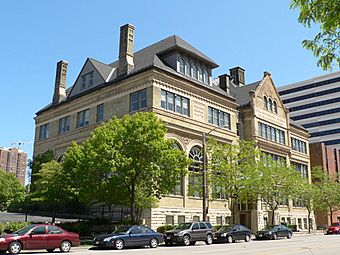German-English Academy Building facts for kids
Quick facts for kids |
|
|
German-English Academy
|
|

German-English Academy Building
|
|
| Location | 1020 N. Broadway Milwaukee, Wisconsin |
|---|---|
| Built | 1891, 1892 |
| Architect | Crane and Barkhausen |
| Architectural style | Romanesque Revival |
| NRHP reference No. | 77000037 |
| Added to NRHP | April 11, 1977 |
The German-English Academy Building is a historic school building in Milwaukee, Wisconsin. It was built in 1891 for the German-English Academy. This school later became the University School of Milwaukee. The Academy was very important when Milwaukee had a large German population. Today, the building is on the National Register of Historic Places. It belongs to the Milwaukee School of Engineering. Since 2012, a company called Direct Supply uses it as a technology center. The building is right next to the Grohmann Museum.
Contents
Building Design and Style
The German-English Academy Building has 3½ stories. It was designed by architects Charles D. Crane and Carl C. Barkhausen. Carl Barkhausen actually went to the German-English Academy himself! He later studied architecture in Germany.
Main Parts of the Building
The building has two main sections, called wings. The entrance is in the middle, connecting these two wings.
The south wing is next to the Grohmann Museum. This part of the building held the classrooms. On the right side of the entrance, there is a small section that sticks out. This part is called a pavilion. It has a neo-Gothic style. The top of this pavilion has a prominent gable end with three arched windows.
The north wing is next to the parking lot. This section of the building contained the gymnasiums.
Roof and Windows
Each wing of the building has a steep hip roof. The north wing has a wide dormer with five windows. A dormer is a window that sticks out from the slope of a roof. This dormer also has its own hip roof.
The back of the building has a similar wide dormer. The north side of the building has a large dormer with a gable front.
History of the Academy
In 1851, some wealthy German immigrants in Milwaukee started the Milwaukee Schulverein (School Association). Many of these founders were "Forty-Eighters." These were progressive people who left Germany after the failed revolutions of 1848–49.
They were not happy with Milwaukee's public schools. They also wanted their children to learn both German and English. So, they opened a private school called the German-English Academy.
New Ideas in Education
Besides teaching German, the Academy brought in new ideas from German education. These included classes in singing, drawing, and domestic science. They also had physical education based on the German Turner movement. In 1873, the Academy started the first kindergarten in Milwaukee.
At first, classes were held in the home of Peter Engelmann, the first teacher. But the school quickly grew too big for that space.
Building the New School
A new building was constructed for the school in 1891-1892. It had two main blocks. The Pfister/Vogel family helped pay for the southern classroom block. This part is 3.5 stories tall and built in the Romanesque Revival style. It has a limestone foundation and walls made of cream-colored brick. You can see bands of windows, small towers on the corners, and small arcades. It also has a hip roof.
The Milwaukee Turner Society paid for the northern gymnasium block. This part is similar but has large windows arranged in arcades. These windows let in lots of light for the gymnasium. It also has tall chimneys. Designs on the gymnasium's terra cotta spandrels show athletic equipment. These include Indian clubs and foils.
Both blocks were designed by Charles D. Crane and Carl C. Barkhausen. They made sure the two parts looked like one unified building.
Learning at the Academy
The new building allowed students to learn many new things. Boys could study manual arts, which means learning skills with their hands. Girls could learn domestic science, which is about managing a home. Both boys and girls took physical education.
The building also had a natural science museum. There were labs for physics and chemistry. The Academy trained many teachers for Milwaukee's public schools. In 1900, the Superintendent of Schools said that "Engelmann's School" was a model for the public school system.
Changes Over Time
During WWI, people became suspicious of anything German. Because of this, the German-English Academy changed its name. It became the Milwaukee University School. In 1927, that school moved to a different location.
In 1930, the building was changed into a furniture store. The inside of the building was greatly changed. In 1933, the Milwaukee School of Engineering bought the building. They started using it for education again. In 1982, the outside of the building was restored. The inside was remodeled into offices.

